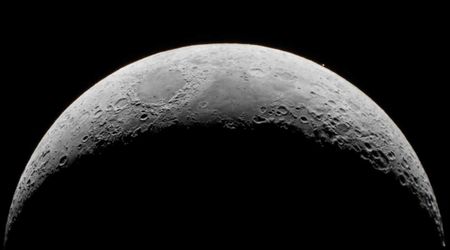Is there gold on the Moon


The short answer to the questions posed in this article title is: Yes! gold traces have indeed been identified within the lunar soil. Back in October 2009, NASA conducted a mission called LCROSS, which involved crashing a booster rocket into the Moon at nearly 6,000 miles per hour.
A second spacecraft equipped with a spectrometer followed closely behind to study the plume of debris released by the impact. The chemicals detected during the analysis include carbon monoxide, carbon dioxide, ammonia, sodium, hydrogen and small traces of gold, silver and mercury. Although the sample size was relatively small, it nonetheless corroborated the presence of gold beneath the lunar regolith. Despite 14 years elapsing since this discovery, measuring the precise quantity of lunar gold has proven to be a challenge so far, primarily due to its subterranean location.
More than 50 years after the last Apollo mission, humanity is on the brink of once again stepping foot on the Moon. As we prepare for this exciting new era of lunar exploration, the question of whether or not the Moon contains substantial deposits of gold could soon be answered.
Why would there be gold on the Moon?
There are two plausible ways that gold may have found its way to our natural satellite:
- Meteorite Impacts: The Moon has been bombarded by meteorites throughout its history, and some of these meteorites could contain gold. When a meteorite impacts the Moon, it can vaporize, melt, or scatter its materials, including gold, onto the lunar surface. For example, asteroid Psyche 16 is apparently holding enough gold to make every human a billionaire, so it’s not far-fetched to think that, throughout its 4.53 billion years of existence, the Moon may have received a few “golden packages” from crashed asteroids.
- Lunar Formation Process: When the Moon formed about 4.53 billion years ago, it was created from the debris of a massive impact between Earth and a Mars-sized celestial body. During this process, some gold from Earth and/or the impacting body may have been incorporated into the Moon's composition.

The surface of the Moon is notably soft, and when an object impacts it, various materials can become embedded deep beneath the lunar terrain.
Where did this gold originate from?
Gold and other heavy elements are created through nuclear reactions that occur in extreme environments. One such cataclysmic event is the explosion of a dying star: a supernova.
During a supernova, the star's core collapses, and its outer layers are ejected into space at incredibly high temperatures and pressures. The extreme conditions during a supernova create an environment where nuclear reactions can produce heavy elements like gold.
The newly formed elements are then dispersed into space, eventually becoming part of interstellar gas and dust clouds. Over the following millions of years following such a powerful cosmic event, some of those elements may find their way into the dust and gases that will eventually coalesce into protoplanets.
Could this gold be mined from the lunar surface?
The idea of mining the Moon is not new, but the challenges that come with it are significant:
- Cost: The cost of mining on the Moon will be incredibly high, and it is not clear if it would be economically viable. Building a mining infrastructure on the moon would require a significant investment of resources and technology.
- Technology: The technology required for mining on the Moon on which the gravity is much weaker than on Earth will need to be highly specialized.
- Environmental Factors: The moon's environment is harsh, and mining would be challenging. The lack of atmosphere means that the surface is exposed to solar radiation and extreme temperature fluctuations, which could damage mining equipment.
- Legal Issues: The Outer Space Treaty of 1967 prohibits countries from claiming ownership of the moon or any other celestial body. This means that any mining activity on the moon would have to be done in partnership with other countries or organizations. In preparation for the Artemis mission, the introduction of the Artemis Accords was done very recently in order to authorize the mining of the Moon for scientific purposes.
- Transportation: It is estimated that it costs around $10,000 to transport one pound of material from Earth to the moon. This cost would need to be significantly reduced in order for lunar mining to be economically viable.
- Established Human presence: There are currently no permanent human settlements on the moon, and building the necessary infrastructure would be a massive undertaking. This includes everything from housing and transportation to power and communication systems.
Would it be worth it to mine gold on the Moon?
At this moment in time, probably not. While it has been proven that the moon contains gold, the amount and accessibility of these resources are still unknown. Mining on the moon could be a high-risk investment with an uncertain return. We just don’t know how much gold there is on the Moon, mainly due to the lack of surface missions over the last 5 decades. More research would need to be done to assess
The other point I’d like to raise is that there are other resources on the Moon, such as water ice and rare earth elements, which are more valuable and relevant for future lunar missions and exploration. As a space exploration fan, I think that mining these resources should be prioritized over gold due to their potential usefulness for sustaining human presence on the Moon and enabling further space exploration.
While it would be naive to not assume that numerous corporations are currently strategizing how to extract resources from the solar system for profit, such as through asteroid mining, my hope is that these commercial endeavours will not come at the expanse of scientific activities and the advancement of space colonization and outer space exploration.





















